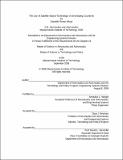| dc.contributor.advisor | Annalisa L. Weigel. | en_US |
| dc.contributor.author | Wood, Danielle Renee | en_US |
| dc.contributor.other | Massachusetts Institute of Technology. Technology and Policy Program. | en_US |
| dc.date.accessioned | 2009-08-25T18:00:03Z | |
| dc.date.available | 2009-08-25T18:00:03Z | |
| dc.date.copyright | 2008 | en_US |
| dc.date.issued | 2007 | en_US |
| dc.identifier.uri | http://hdl.handle.net/1721.1/46371 | |
| dc.description | Thesis (S.M.)--Massachusetts Institute of Technology, Dept. of Aeronautics and Astronautics; and, (S.M.)--Massachusetts Institute of Technology, Engineering Systems Division, Technology and Policy Program, 2007. | en_US |
| dc.description | This electronic version was submitted by the student author. The certified thesis is available in the Institute Archives and Special Collections. | en_US |
| dc.description | Includes bibliographical references. | en_US |
| dc.description.abstract | Satellite technology in the areas of remote sensing, communication, and navigation can provide valuable information in a number of areas from business to disaster management to agriculture. There is great potential for such technology to help solve problems in developing countries. Unfortunately, due to lack of funds, expertise, equipment or awareness, developing countries are not using satellite technology to its full potential. This thesis is motivated by a desire to increase and improve the use of satellite-based technology in developing countries. Three Research Questions guide the study. Question 1 is, "How does national development level relate to national space activity?" For this question, national development level is measured by a series of Development Indicators such as Gross Domestic Product. The level of space activity is measured using a Space Participation Metric that is created by the author. Statistical analysis is used to learn if there is any significant difference in the space activity of countries at different development levels. Research Question 2 asks, "What Mission and Management Architectures are developing countries using to apply satellite-based technology to national needs?" The data used to answer this question comes from 90 Space Project Case Studies about satellite-enabled activities in Africa. The information from the Case Studies is organized so that trends can be found in the accomplishments of the projects. Research Question 3 asks, "How does national development level influence the Mission and Management Architectures used by developing countries in satellite-based technology projects?" This question builds on the data from Research Question 2. | en_US |
| dc.description.abstract | (cont.) Statistical analysis is used to determine if African countries at different development levels perform differently in the Space Project Case Studies. In addition to addressing these three Research Questions, this study explores the policy context of African countries through a series of interviews. Thirty interviews were held with representatives from African embassies in the United States. The interview questions explore the institutional structure of the country?s National Innovation System. To summarize the results, the analysis for Question 1 shows that there is a significant difference in the space activity of countries at different development levels. Question 2 shows that most African space projects involve either one African country or a collaboration with a non-African partner. The third Research Question shows that there is a significant difference in the level of technical expertise and programmatic leadership shown by African countries at different development levels. This study closes with policy recommendations for developing country policy makers about next steps for using satellite-based technology. Thesis Supervisor: Annalisa Weigel Assistant Professor, Aeronautics and Astronautics and Engineering Systems Division | en_US |
| dc.description.statementofresponsibility | by Danielle Renee Wood. | en_US |
| dc.format.extent | 165 p. | en_US |
| dc.language.iso | eng | en_US |
| dc.publisher | Massachusetts Institute of Technology | en_US |
| dc.rights | M.I.T. theses are protected by
copyright. They may be viewed from this source for any purpose, but
reproduction or distribution in any format is prohibited without written
permission. See provided URL for inquiries about permission. | en_US |
| dc.rights.uri | http://dspace.mit.edu/handle/1721.1/7582 | en_US |
| dc.subject | Aeronautics and Astronautics. | en_US |
| dc.subject | Technology and Policy Program. | en_US |
| dc.title | The use of satellite-based technology in developing countries | en_US |
| dc.type | Thesis | en_US |
| dc.description.degree | S.M. | en_US |
| dc.contributor.department | Massachusetts Institute of Technology. Department of Aeronautics and Astronautics | |
| dc.contributor.department | Massachusetts Institute of Technology. Engineering Systems Division | |
| dc.contributor.department | Technology and Policy Program | |
| dc.identifier.oclc | 422549683 | en_US |
